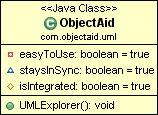ObjectAid Alternatives

ObjectAid
The ObjectAid UML Explorer is different from other UML tools. It uses the UML notation to show a graphical representation of existing code that is as accurate and up-to-date as your text editor, while being very easy to use. Several unique features make this possible:
You simply drag your Java classes onto a diagram from other Eclipse views; no need to start a lengthy reverse engineering job.
Your source code and libraries are the model that is displayed, they are not reverse engineered into a different format.
If you update your code in Eclipse, your diagram is updated as well; there is no need to reverse engineer source code.
Refactoring updates your diagram as well as your source code. When you rename a field or move a class, your diagram simply reflects the changes without going out of sync.
All diagrams in your Eclipse workspace are updated with refactoring changes as appropriate. If necessary, they are checked out of your version control system.
Diagrams are fully integrated into the Eclipse IDE. You can drag Java classes from any other view onto the diagram, and diagram-related information is shown in other views wherever applicable.
The ObjectAid UML Explorer achieves all this while staying light, fast and easy to use. In addition, exploring code is easy because you can find and add related classes with a right-click from the context menu.
Best ObjectAid Alternatives for Iphone
Looking for a program that is like ObjectAid? We have our top picks here. If you need another program that has some of the features of ObjectAid on your device, read what we recommend in this post.

Lucidchart
FreemiumWebAndroidiPhoneChrome OSMicrosoft Office WordGoogle DriveGoogle Drive - DocsGoogle AppsGoogle Drive - SheetsMicrosoft Office SuiteOnline diagram and flowchart software that supports Microsoft Visio import and can work on any operating system.
Features:
- Real time collaboration
- Team Collaboration
- Charts
- Flow chart
- General-purpose diagramming
- UI Design
- Prototyping
- Real time collaboration
- Export to PDF
- Scalable UI
- Sequence Diagrams
- UML diagrams
- Visitor management
- Web-Based
- Wireframing
ObjectAid Reviews
Add your reviews & share your experience when using ObjectAid to the world. Your opinion will be useful to others who are looking for the best ObjectAid alternatives.
Table of Contents